Since the fall of the Assad regime on December 8, 2024, the United Nations High Commissioner for Refugees (UNHCR) has reported that 719,801 Syrian refugees have returned to Syria from neighboring countries, including 205,323 from Lebanon, as part of voluntary return programs. This article details the UNHCR’s efforts to facilitate these returns, the support provided to returnees, and the collaborative initiatives between Lebanon and Syria to ensure a safe and organized process.
Scale of Returns
According to UNHCR spokesperson in Syria, Celine Schmitt, an estimated 719,801 Syrian refugees have returned from neighboring countries since December 8, 2024, following the end of decades of Ba’ath Party rule. Of these, 205,323 returned from Lebanon, where approximately 1.5 million Syrian refugees reside, representing the highest per capita refugee population globally. The returns are part of UNHCR’s voluntary return programs, designed to ensure safe and dignified repatriation.
First Organized Convoy from Lebanon
On July 29, 2025, the UNHCR, in coordination with its Lebanon office and the Syrian General Authority for Land and Maritime Ports, launched the first organized voluntary return convoy from Lebanon to Syria. The convoy comprised 72 refugees across 14 families, with some heading to Homs and others to rural Damascus areas, including Qatana, Zabadani, Babila, Nashabiyeh, and Daraya. The UNHCR provided transportation for the refugees and their belongings, alongside support to facilitate their reintegration into local communities.
Support for Returnees
The UNHCR connects returnees to community centers in Syria, offering essential services such as legal assistance for obtaining civil documentation, psychosocial support, livelihood opportunities, and protection services. Schmitt noted that over 17,000 Syrian refugees in Lebanon registered for the voluntary return program by July 14, 2025, receiving detailed consultations on the process and its legal and social implications. The agency also provides logistical support, including transportation, to meet returnees’ immediate needs and aid their reintegration.
Lebanese-Syrian Coordination
The Lebanese government initiated the first phase of its refugee return plan on July 29, 2025, with a convoy departing from Bar Elias in the Bekaa region via the Masnaa border crossing. The operation, coordinated by Lebanon’s General Security Directorate and Syrian authorities, involved no border fees and provided essential services to ensure a smooth reception. Lebanese Minister of Social Affairs Hanine Al-Sayyed stated that returnees receive $100 per individual and $400 per family upon arrival in Syria, with transportation costs covered. The plan targets the return of 200,000 to 400,000 refugees in 2025, focusing on those in informal settlements.
Lebanese Prime Minister Najib Mikati emphasized ongoing cooperation with Syria on border control, anti-smuggling efforts, and refugee returns, underscoring the need for coordinated stability. President Joseph Aoun highlighted that Syria’s stability directly impacts Lebanon, noting the significant burden of hosting refugees and calling for a comprehensive review of management mechanisms.
Challenges and Broader Context
The UNHCR has warned that insufficient funding threatens the sustainability of these returns. Only $71 million of the required $575 million for its 2025 Syria programs has been pledged, risking reduced support for the projected 1.5 million refugee and 2 million internally displaced person (IDP) returns. Without adequate resources, many returnees may face challenges such as damaged homes, economic hardship, and risks from unexploded ordnance, potentially prompting further displacement.
The International Organization for Migration (IOM) reported that 1.87 million Syrians, including refugees and IDPs, have returned since December 2024, but economic opportunities and basic services remain major obstacles. The agency stressed Syria’s urgent need for international support to rebuild infrastructure and sustain returnees.
The return of over 719,000 Syrian refugees since December 2024 marks a significant development following the political transition in Syria. The UNHCR’s voluntary return programs, supported by Lebanese-Syrian coordination, aim to ensure safe and dignified repatriation. However, challenges such as funding shortages and infrastructure deficits underscore the need for robust international support to sustain these efforts and prevent further displacement.
This article was translated and edited by The Syrian Observer. The Syrian Observer has not verified the content of this story. Responsibility for the information and views set out in this article lies entirely with the author.


